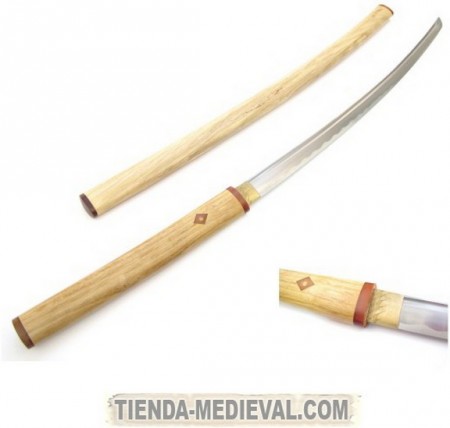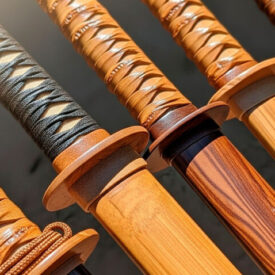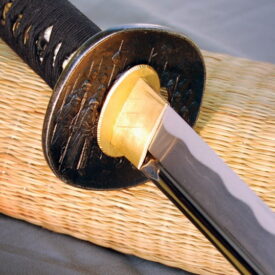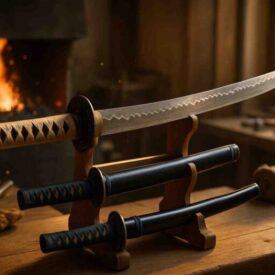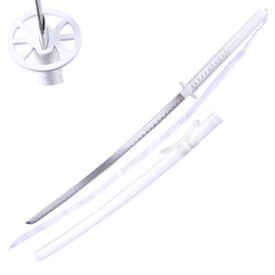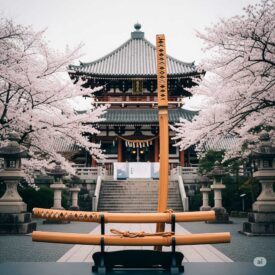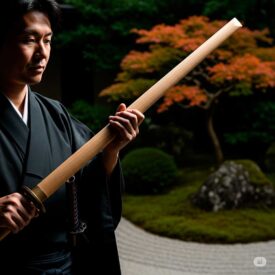What does a legendary blade guard when it is not destined to sing in battle? The answer is simple yet nuanced: a shirasaya, the white scabbard that breathes history and preserves steel. This minimal, seemingly humble mounting has been the guardian of katanas for centuries, defending the temper of the steel from the corrosive silence of time.
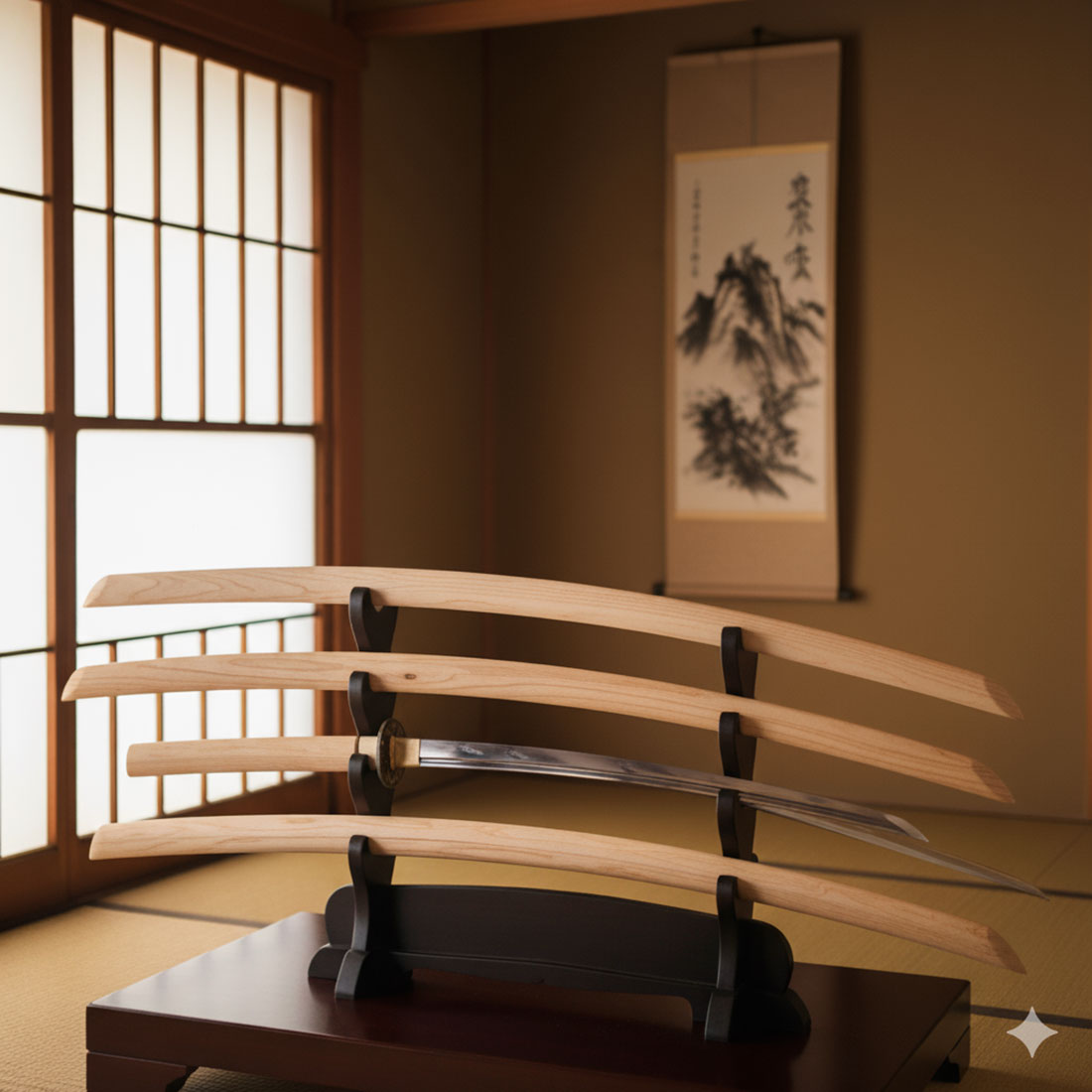
Why a shirasaya matters as much as the blade
The shirasaya is not an ornamental piece. It is a technical and cultural decision that reveals how Japanese artisans valued, above all, the preservation of the blade. When the katana remains unused for long periods, how it is stored determines whether it will reach the next generation intact or be lost to rust spots.
In this article, you will learn: what exactly a shirasaya is, how it differs from other mountings such as the koshirae or the shikomizue, why its unlacquered wood is vital for conservation, how a proper sayagaki is performed, what oils and care tradition and modern practice recommend, and what characteristics to look for if you want a faithful replica or a conservation mounting for your blade.
Evolution and function of the shirasaya in the history of the Japanese sword
The consulted sources do not offer exact dates for the origin or development of the shirasaya, but they clearly describe its traditional purpose, its relationship with the definitive mounting (koshirae) and its role in historical contexts such as the conception of disguised weapons and the authentication of valuable katanas.
| Era | Event |
|---|---|
| Sources and chronological limitations | |
| No specific date | Sources do not provide a chronology with precise dates or eras for the origin of the shirasaya. The available information describes its function and traditional use rather than its date of appearance. |
| Origin and traditional purpose (undetermined temporality) | |
| Traditional use | The shirasaya is the traditional method of storing Japanese blades. It is used when the blade is not going to be used for a while or should be preserved for a long period. |
| Contrast with the koshirae | Unlike the koshirae, which is an ornamental and functional mounting designed to carry and use the sword in combat, the shirasaya prioritizes the protection and conservation of the blade. |
| Conceptual mounting sequence (first simple, then elaborate) | |
| Simple initial mounting | Originally the blade was simply mounted in a natural wooden hilt and a matching scabbard (shirasaya), evidencing the predominant value of the blade over external ornament. |
| Subsequent elaboration | Over time, the sword could receive its definitive mounting (koshirae), more elaborate and including elements such as the guard (tsuba), the hilt wrapped in ray skin, and the silk braiding (tsuka-ito). |
| 19th Century: restrictions and disguised weapons (approximate historical context) | |
| Restrictions and response | Following restrictions on carrying swords imposed by an Imperial Edict in the 19th century, the need for disguised weapons arose. Although the shirasaya is not designed for combat, its wooden simplicity was imitated by the shikomizue (prepared cane) to conceal a sword as a combat-ready cane. |
| Contemporary era: conservation and authentication | |
| Authentication and conservation | In contemporary contexts and historical study, the storage shirasaya contributes to the authentication of valuable or historically significant katanas and remains the recommended traditional practice for preserving blades when not in use. |
Technical definition: what makes up a shirasaya?
A shirasaya is basically formed by two pieces of wood: the saya (scabbard) and the tsuka (hilt), usually made of magnolia or other woods with low resin content. The construction prioritizes the absence of lacquers, varnishes, or materials that retain moisture. It is a mounting designed for calm — not for battle — and therefore lacks tsuba, ito, and same.
Key features:
- No tsuba: absence of a guard to prevent points where moisture can accumulate.
- Unwrapped tsuka: no silk braiding or ray skin.
- Unlacquered wood: allows the saya to “breathe” and better control internal moisture.
- Mekugi-ana: the necessary holes in the tsuka to secure the tang (nakago) of the blade.
These features are not an aesthetic whim: they respond to a conservation criterion that prioritizes the chemical stability of the blade and the possibility of inspection and sayagaki without damaging the steel.
The shirasaya versus the koshirae and the shikomizue
Understanding the difference between these mountings is essential for anyone working with Japanese swords. The koshirae is the complete, ornate mounting, usable in combat or for display. The shirasaya is its functional opposite: simple, practical, and dedicated to storage. The shikomizue, for its part, is a mounting that imitates a cane and can conceal a blade with intent to use.
- Koshirae: definitive mounting, lacquered and decorated, designed to carry the sword.
- Shirasaya: conservation mounting, unlacquered and designed for prolonged storage.
- Shikomizue: camouflaged mounting, can be used as a hidden weapon.
In practical terms: you would never use a shirasaya in combat; it does not protect the wearer or ensure a firm grip. Its greatness lies in preserving the blade so that, when the time comes, it can be dressed with its koshirae without a trace of corrosion.
Materials and execution: how a traditional shirasaya is made
Traditional construction starts with two sheets of natural wood, carefully carved and fitted to embrace the sword tang. Traditional adhesive can be rice glue or other natural adhesives; the precision of the carving is critical because the saya must hold the blade without allowing movements that cause chafing or micro-bumps.
Essential steps in manufacturing:
- Wood selection: a wood with low resin content is chosen.
- Carving and fitting: the saya cavity is adjusted exactly to the shape of the nakago (tang).
- Assembly: the two halves of the saya are joined, leaving space for the extraction and placement of the blade.
- Sayagaki inscription (optional): some shirasayas include annotations that certify the origin or history of the blade.
The result is a sober wrapping that protects without interfering with the chemistry of the steel: unlacquered wood absorbs small variations in humidity and reduces condensation inside the scabbard.
Sayagaki: the signature of history on wood
The sayagaki is the practice of writing relevant information about the sword on the saya: smith’s name, era, provenance, or authentication notes. This calligraphy adds documentary value that can be decisive for historians and collectors, but it requires skill because the writing must preserve the integrity of the storage.
A well-executed sayagaki functions as a historical label. It provides context and can transform a simple wooden scabbard into a portable archive of the blade it contains.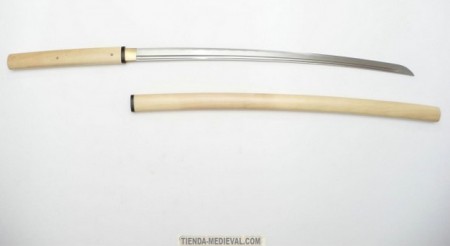
Measurements, adjustment, and safety considerations
A suitable shirasaya must be precisely adjusted. The nakago (tang) must fit without lateral play and with sufficient depth to prevent movement. In terms of measurements, a complete katana can range from 100–104 cm, with blades of 60–73 cm depending on the style. For wakizashi or tanto, the shirasaya is proportionally reduced.
- Adjustment: the saya must not allow the blade to move abruptly.
- Mekugi-ana: the hole(s) must coincide to allow the tsuka to be secured if necessary.
- Periodic inspections: open and check the blade at least once a year to detect signs of corrosion.
Blade care in shirasaya: oils and maintenance
Protecting the blade inside a shirasaya is not a passive act. A preventive maintenance routine based on cleaning, inspection, and light protection with appropriate oils or greases is recommended. Below are typical comparisons of products used to preserve steel.
| Oil Type | Main Characteristics | Recommended Use |
|---|---|---|
| Mineral Oil | High penetration, does not degrade or attract dirt | Regular protection and maintenance |
| Camellia Oil | Natural, acid-free, non-volatile | Antioxidant protection, lubrication |
| Lithium Grease | Dense, durable, non-evaporating | Prolonged storage, protection |
Recommended practices:
- Cleaning before storage: remove fingerprints, dust, and debris with a cotton cloth lightly dampened with rubbing alcohol (use with care).
- Oil application: a light and even layer, without excess, applied with a soft cloth to prevent accumulations.
- Avoid oils with acidic or corrosive additives; prefer neutral or camellia oils according to tradition.
- Environmental control: stable temperatures and moderate relative humidity reduce the risk of condensation.
Types and selection: how to choose a shirasaya for conservation or display
Choosing a shirasaya involves decisions: are you looking for historical fidelity, specific wood, sayagaki, or a mounting designed for modern exhibition? Options range from replicas in alternative woods to mountings created with museum criteria.
Tips for selection:
- Prefer unlacquered wood with a reputation for low resin.
- Verify the fit with the blade or provide exact nakago measurements for custom work.
- If you are looking for documentation, request the possibility of sayagaki or a label describing the origin of the piece.
Advanced conservation: measures for demanding collectors
Collectors who guard authentic blades apply more rigorous protocols: humidity control with desiccants in display cases, periodic rotation of the blade out of the saya for inspection, and photographic documentation. Some professionals recommend storing the blade wrapped in acid-free quality paper before inserting it into the saya to reduce direct contact that could leave marks.
Solutions for adverse environments:
- Use display cases with humidity control.
- Avoid storage in basements, attics, or places with pronounced temperature fluctuations.
- Check door and window seals to reduce moisture infiltration.
Legal and historical aspects to consider
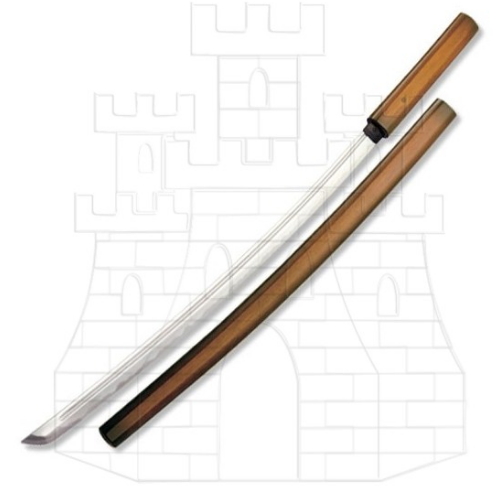 The shirasaya gains historical relevance in contexts where carrying or displaying weapons was restricted. Its presence in archives, collections, and catalogs provides clues about the use and circulation of the sword in specific eras. Furthermore, the sayagaki, when present, can be a documentary clue that aids in authentication processes.
The shirasaya gains historical relevance in contexts where carrying or displaying weapons was restricted. Its presence in archives, collections, and catalogs provides clues about the use and circulation of the sword in specific eras. Furthermore, the sayagaki, when present, can be a documentary clue that aids in authentication processes.
Clarifying doubts about the shirasaya and the shikomizue
What is the difference between a shirasaya and a shikomizue?
The main difference between a shirasaya and a shikomizue is their purpose and design:
- The shirasaya is a simple wooden saya and hilt, without ornaments or protection, designed exclusively for the long-term storage of a Japanese sword blade. It has no guard (tsuba) or a hilt prepared for combat, so it is not intended for use in battle. Its function is to protect the blade from moisture and corrosion when not in use.
- The shikomizue is a hidden mounting that disguises the sword as a cane or walking stick, allowing the weapon to be concealed and used as such. It is designed for concealment and potential combat use, although it is not a traditional mounting for battles. As a sword-cane, it can be used as a disguised weapon.
In summary: the shirasaya is for safe storage and conservation, while the shikomizue is for hiding the sword by disguising it as a cane with possible functional use as a hidden weapon.
What materials are traditionally used to make a shirasaya?
The materials traditionally used to make a shirasaya are two untreated natural wood sheets, usually of the nurizaya type or similar woods with low resin content, joined with rice glue or another natural adhesive. This unvarnished wood allows the scabbard to absorb moisture, helping to keep the stored blade in optimal conditions. The shirasaya is a simple, undecorated type of scabbard, intended to protect the blade when not in prolonged use.
How is the sayagaki process performed on a shirasaya?
The sayagaki process on a shirasaya consists of writing or inscribing (sayagaki) on the white wooden scabbard (shirasaya) where the katana blade is stored to explain or document important details about the sword, such as its origin, quality, or history. This practice is a specialized task that must be carried out carefully, often by a notable expert, using ink and traditional Japanese calligraphy to record it on the saya (scabbard) without damaging the integrity of the blade’s storage.
In summary, sayagaki is a written annotation process on the shirasaya, used to identify and certify the value and provenance of the katana protected within this simple, unadorned scabbard.
What characteristics make a shirasaya ideal for storage?
An ideal shirasaya for storage should have the following characteristics:
- Construction from natural wood without lacquer or varnish, to allow the blade to “breathe” and prevent moisture retention that can cause corrosion.
- Minimalist and undecorated design, which reduces elements that could trap moisture or particles that damage the blade.
- Absence of combat elements such as tsuba (guard) or ito (grip wraps), to maximize protection and preservation.
- Precise fit so that the blade is firmly protected and does not move within the scabbard, preventing mechanical damage.
These characteristics allow the integrity, sharpness, and quality of the sword’s steel to be preserved by protecting it from moisture, dirt, sweat, and blood when not in use.
Are there different types of shirasayas depending on their use or historical period?
Yes, there are different types of shirasayas depending on their use and historical period.
The shirasaya originally developed as a simple white wooden scabbard without ornaments or combat components, intended to store and protect the katana blade when not in use, especially during the Edo period (1603-1868). During this period, due to laws limiting the carrying of weapons in public, the shirasaya allowed the sword to be kept without displaying it as a weapon. In addition, it was used to transport the protected blade before mounting the definitive ornamental pieces. Therefore, the primary use of the shirasaya was for storage, transport, or display, not for combat.
Regarding types, although the basic design is similar (a wooden scabbard and handle without ornaments, neither tsuba nor wraps), shirasayas can be found for different sword styles (katana, wakizashi, etc.) and sometimes include inscriptions to identify the blade they guard. Currently, there are also modern shirasayas that maintain the simplicity of the traditional form but can vary in materials and finishes depending on the manufacturer.
Therefore, shirasayas vary mainly according to their historical function — storage and protection at home or safe transport — and the type of sword they contain, rather than significant differences in their basic form.
| Oil Type | Main Characteristics | Recommended Use ||——————|—————————————————-|—————————————–|| Mineral Oil | High penetration, does not degrade or attract dirt | Regular protection and maintenance || Camellia Oil| Natural, acid-free, non-volatile | Antioxidant protection, lubrication || Lithium Grease | Dense, durable, non-evaporating | Prolonged storage, protection |
| Oil Type | Main Characteristics | Recommended Use |
|---|---|---|
| Mineral Oil | High penetration, does not degrade or attract dirt | Regular protection and maintenance |
| Camellia Oil | Natural, acid-free, non-volatile | Antioxidant protection, lubrication |
| Lithium Grease | Dense, durable, non-evaporating | Prolonged storage, protection |
- Hispaniensis
-
- Blade Length: 60–68 cm (approx.)
- Era: 3rd–1st centuries B.C.
- Tactical Use: Versatile: powerful cuts and thrusts in closed formations.
The legacy of the shirasaya and final best practices
The shirasaya is a practical art. Its value lies in its modesty: a simple wooden scabbard that protects what truly matters, the blade. Knowing its history, its function, and how to care for it allows you to keep the tradition alive and preserve the piece for future generations.
Key points to remember:
- The shirasaya protects; it is not for combat.
- Unlacquered wood and precise fit are essential.
- Proper inspection and oiling prolong the life of the blade.
- Sayagaki provides historical context and documentary value.
